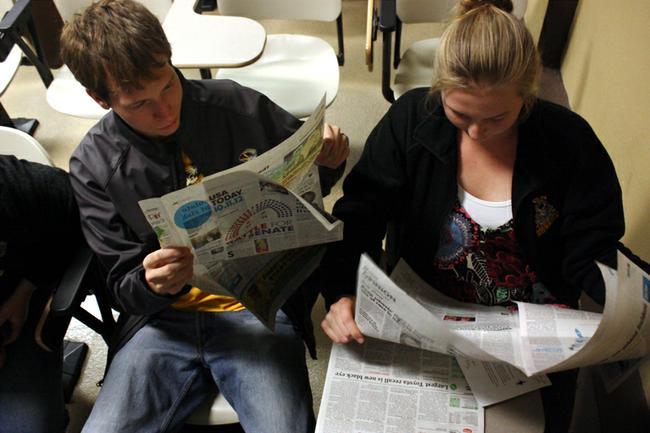
Even with the loss of advertising revenue and subscriptions, newspaper publishers hold an optimistic view of the future of print journalism, a study conducted by MU researchers found.
“It’s kind of astounding considering the newspaper business has been in rough seas the last few years,” said Michael Jenner, the Houston Harte Endowed Chair at the MU School of Journalism, who headed up the survey. “Two-thirds said they were on the optimistic side, 31 percent said they were neutral, and a small portion — around 4 percent — were not optimistic.”
Jenner was aided in his investigation by researchers from the Reynolds Journalism Institute.
“In the survey, we simply asked a question about the level of optimism with one being not at all optimistic and five being very optimistic,” said Kenneth Fleming, the associate director of research at RJI. “The question was, ‘How optimistic do you feel about the future of the newspaper industry?’ leaving the word optimism up to respondents to interpret for themselves.”
According to a news release from the MU News Bureau, the survey also showed that 90 percent of the publishers interviewed have put in place digital publications that they expect to increase revenue for the company.
“Nowadays, when you talk to a newspaper executive, whenever you talk about news gathering, unless you specify, you are talking about both (print and online) because it is all moving towards convergence journalism,” Fleming said. “Meaning that newspapers not only continue to develop print products but are also getting into mobile as well as social media platforms.”
The survey was conducted by interviewing 458 publishers of U.S. daily newspapers, which encompassed around one-third of the newspapers in America, Jenner said.
“In terms of number of publishers involved and scope of the questions, it’s the largest survey of its kind we are aware of,” Jenner said.
The study showed that there are several reasons for the increased optimism.
“One reason may be simply that this year is looking better than the last four or five,” Jenner said. “We look for predictors — are there any of these things we asked about that are indicators of optimism? One of the things we found was that newspapers that are embracing a digital future are more optimistic than those that are lagging behind.”
Though the study only looked at the opinions of those related to the print industry, Jenner said because of how the survey was conducted, there is little reason for the publishers to give an inaccurate view of the state of print media.
“It may be that some of these guys are in denial or are saying that they are optimistic because they have to be,” he said. “On the other hand, at some point you have to assume people are going to tell you the truth. The responses suggest that many publishers believe their franchises are still strong. Many see a strong future in print, and many believe their operations are capable of making the transition to digital.”
According to Fleming, the study is the first of its kind at MU, and therefore there is not much history with which to compare it.
“We will implement these surveys every year,” Fleming said. “We plan to do this with the same questions this year as next year and year after. Over time, we will be able to collect a pretty rich source of data.”